Text types: Stories
| Linking clauses to create a story |
Vocabulary patterns
The vocabulary patterns in a story tells us what the story is about, for example a visit by sisters to a theme park, animals having a race, a girl hero of Ancient China. In longer stories the vocabulary patterns can be quite complex. Vocabulary patterns help build up and weave together all the different elements of the story world, ie setting, characters, plot and atmosphere.
A common vocabulary pattern in stories is repetition. Storytellers repeat words which tell us who and what the story is about. For example, the narrative Adventure at Ocean Park is about a visit by two sisters to a theme park. For this reason the names of these two main characters are repeated through out the story:
|
|
Lara Rosie |
Words used to describe the setting are also repeated:
|
|
mother sister car |
The storyteller also uses words which refer to parts of the theme park
setting:
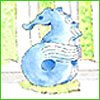 |
parts of a theme park |
| rides roller coaster entrance path hill cable car |
There are also clusters of words, or collocations, we can predict the
storyteller will use to write about this setting:
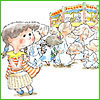
collocations fast
fun
scary
crowd
children
people
When people visit a theme park, they go to see the
different attractions. In the ORIENTATION
stage of the narrative, Adventure at Ocean Park, the storyteller tells us which attractions Rosie likes. As the
PROBLEM
stage of the story unfolds, Lara tries to find Rosie by going to these
attractions. She also goes to another attraction by following Rosie's trail. As
the story unfolds, the storyteller uses the vocabulary which refers to these
attractions. Many of these words are repeated. The table below shows some of the
patterns the storyteller makes with these words.
| Vocabulary Pattern |
|
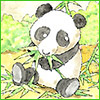
|
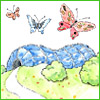
|
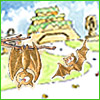
|
words which refer to different types of attractions |
Kids' World | Panda Habitat | Butterfly House | Ancient World |
|
words which refer to parts of the attractions |
merry-go-round train |
pandas front Jia Jia |
butterfly cocoon |
ruins cave |
collocations of words associated with the attractions |
horse
with the blue ribbon bob up and down whistle track chugged laugh wave |
pandas bamboo munching interesting pointing |
dazzled colour thousands |
bat |
The storyteller uses one of the words from Rosie's
favourite attraction, the Butterfly House, for Rosie's clue, the trail of
butterfly clips. This creates further repetition of the word butterfly.
Here are the words which are used to write about Rosie's clue.
|
|
butterfly clips sparkly trail hair packet |
The storyteller also uses sets of words, or collocations, which go together
to describe Lara's physical and mental feelings. These words help shape the plot and build the
atmosphere and suspense. ![]()
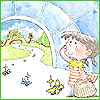 |
physical | mental | |
| walked slowly followed deep breath heart beating run palms |
sweaty puffing scream tears hug giggle laugh wink |
worry uneasy calm scared petrified relief pleased |
|
The vocabulary patterns of the narrative Adventure at Ocean Park are quite complex. In contrast the vocabulary patterns of the short fable The Hare and the Tortoise are more straightforward. The fable is about two characters, a hare and a tortoise, and a race, so the words Hare, Tortoise and race are repeated throughout the story. There are different types of animals mentioned in the fable (hare, tortoise, fox). There is also a set of words which are collocations of the word race (mark out, course, judge, sprinted, catch up, beat, end of the course, raced, finish line, crossed).
| To see how the vocabulary patterns are used to link all the clauses of the fable The Hare and the Tortoise, click here: |  |
|
Tell me more ... Focus on grammar |
|
||
To give us feedback about this section, click here or on the Comment button at the top of the screen.
If you have any questions about this section, visit the Language Corner.
If you have any questions or suggestions about how to teach this section, send a message to the Teaching Corner.